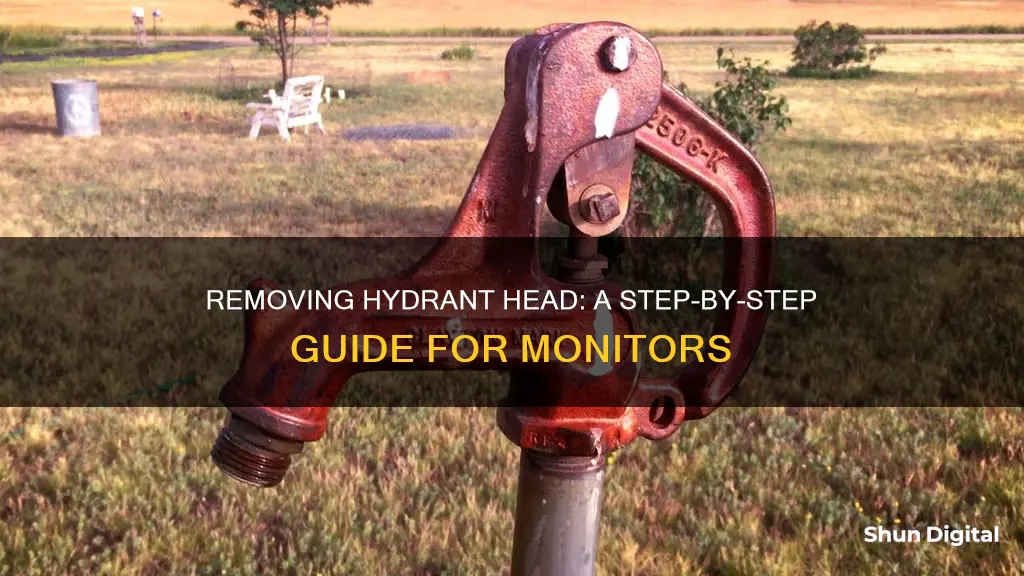
Monitor hydrants are produced by Baker Water Systems and are known for their dark green hydrant head and uncommon handle position. They are commonly used year-round for home, lawn, and farm applications. The Monitor hydrant has a cast iron collar, stainless steel hex screws, and a handle made of ductile iron. Its lever is located at the top of the hydrant for easy access.
To remove the Monitor hydrant head, first, shut off the water supply to the hydrant. Then, remove the hydrant head from the standpipe using two pipe wrenches. Place one wrench on the standpipe to keep it in place and the other on the hydrant head to unscrew it. If the head is difficult to remove, apply some penetrating oil to the pipe threads and try again.
Once the hydrant head is removed, you can access the internal components for repair or replacement.
What You'll Learn

Shut off the water supply
Shutting off the water supply is an important first step when removing a monitor hydrant head. Here is a detailed, step-by-step guide on how to do this:
Locate the main shut-off valve: The first step is to find the main shut-off valve for your water supply. This valve is usually located near the main water pipe that leads into your home. It could be inside your home, typically in the kitchen, basement, or utility room, or outdoors, depending on the climate.
Turn off the water supply: Once you have located the main shut-off valve, it's time to turn off the water supply. To do this, turn the valve clockwise. This will cut off the stream of water flowing into your home. Make sure to wear gloves while doing this, as the valve may be stiff and require some force to turn.
Flush the remaining water: After turning off the main valve, turn on all the faucets in your home, including sinks, baths, and showers. Let the water run until there is no more water flowing from the faucets. This step is crucial to ensure that all the water in the pipes has been flushed out.
Handle indoor fixtures: If you need to work on a specific fixture, such as a faucet, shower, or toilet, look for individual shut-off valves near those fixtures. These valves are usually located beneath the fixture or on the water supply tubes connected to the fixture. Turn these valves clockwise to shut off the water supply to that particular fixture.
Prepare for repairs: With the water supply shut off, you can now proceed with any necessary repairs or maintenance on your monitor hydrant head. Remember to keep a bucket handy to catch any remaining water that drains from the pipes during the repair process.
- Always shut off the water supply closest to the indoor plumbing, rather than the main valve near the street. This is important for accessibility and safety reasons.
- If you have appliances with reservoirs, such as toilets, they may still have limited usage even after cutting off the water supply.
- When restoring water supply after repairs, run faucets and water-using appliances to bleed air from the pipes.
- If you cannot locate the shut-off valve or if it is frozen or defective, contact a licensed plumber for assistance.
Easy Removal of Biotel Holter Monitor: A Step-by-Step Guide
You may want to see also

Loosen the hex screw
To loosen the hex screw, you will need to follow these steps:
Firstly, identify the type of screw. In this case, it is a hex screw, which has a raised hexagonal head. This is different from an Allen screw, which has a hexagonal slot. Once you have identified the screw type, you can gather the appropriate tools.
For a hex screw, you will need a hexagonal socket wrench that fits the head securely. If you do not have a hexagonal socket wrench, you can also use a regular wrench or a pair of pliers. Ensure that the wrench or pliers fit the head securely, as a loose fit may cause the head to strip, making it difficult to turn.
If the hex screw is already stripped or stuck, you may need to try alternative methods to loosen it. Here are some techniques that can help:
- Use a rotary tool with a grinding wheel to grind a slot in the head of the screw. Once the slot is created, you can use a flat-head screwdriver to turn the screw and loosen it.
- Apply a spray lubricant to the screw to help loosen it. Then, use locking pliers to clamp onto the head and turn the screw.
- If the head of the screw is exposed, you can try using a pair of vise grips to loosen it. Alternatively, use a sharp chisel and a hammer to catch the edge of the head and turn it counterclockwise.
By following these steps and techniques, you should be able to successfully loosen the hex screw on the monitor hydrant head. Remember to be careful and patient during the process to avoid further complications.
Blocking Blue Light: Monitor Adjustments for Better Sleep
You may want to see also

Pull out the PVC wet pipe
To pull out the PVC wet pipe, follow these steps:
First, turn off the water supply. This is an important preliminary step to prevent any water wastage or accidental damage to the pipe.
Next, loosen the hex screw in the collar. The collar is the cast iron part of the hydrant head, and the hex screw is made of stainless steel. By loosening this screw, you will be able to remove the hydrant head and access the PVC wet pipe.
Now, you can pull out the PVC wet pipe. This pipe is likely connected to the water supply, so be gentle to avoid any damage to the threads or fittings.
Before reinstalling the pipe, apply a thin coat of vaseline to the O-rings. This will help create a watertight seal and ensure the hydrant functions properly.
Finally, install the wet pipe back into the hydrant stand pipe. Make sure the handle is in the closed position, and bottom out the head casting on the stand pipe. Rotate the head casting outlet in a clockwise direction, looking down on the head, to the desired direction. Ensure the collar is perpendicular to the stand pipe, and tighten the hex screw, being careful not to over-tighten.
By following these steps, you can safely and effectively pull out and reinstall the PVC wet pipe of your monitor hydrant.
Large Monitor, Large Experience: 42-Inch TV as PC Display
You may want to see also

Apply a thin coat of Vaseline to the O-rings
When removing a monitor hydrant head, the process is simple and easy. Here are some detailed steps to ensure you effectively apply a thin coat of Vaseline to the O-rings:
- Before beginning, ensure you have turned off the water supply to the hydrant. This is crucial to avoid any accidental leaks or spills.
- Loosen the hex screw in the collar of the hydrant head. This will allow you to access the O-rings for maintenance.
- Pull out the PVC wet pipe. This step is necessary to gain better access to the O-rings, which are located within the hydrant head assembly.
- Take a small amount of Vaseline and apply it thinly and evenly to the O-rings. Ensure that you coat the entire surface of each O-ring. Vaseline, or petroleum jelly, acts as a lubricant and can help prevent leaks and reduce friction, ensuring the O-rings function optimally.
- Reinsert the wet pipe back into the hydrant stand pipe. Ensure that the handle is in the closed position before proceeding.
- Bottom out the head casting on the stand pipe. This means adjusting the head casting outlet to the desired direction, typically clockwise when looking down at the head.
- Check that the collar is perpendicular to the stand pipe. This ensures a proper seal and alignment.
- Finally, tighten the hex screw. Be careful not to over-tighten, as this can cause damage.
By following these steps, you will effectively apply Vaseline to the O-rings of your monitor hydrant, helping to maintain its functionality and prevent leaks.
Finding Hertz: Monitor Refresh Rates Simplified
You may want to see also

Reinsert the wet pipe
Once you have removed the hydrant head and pump rod, you can now reinsert the wet pipe.
First, apply a bead of silicone RTV, which is NSF or ANSI rated for contact with foods, such as Dow Corning 732, to the threads on top of the wet pipe assembly.
Next, install the new wet pipe assembly into the head by turning it clockwise when viewing from the bottom of the spool. Tighten until the upper thread bottoms in the hydrant head.
Now, reinsert the head assembly and wet pipe assembly back into the standpipe (which must be completely drained). Ensure that the handle is in the closed position. Bottom out the spool in the valve body and tighten the set screw in the hydrant head collar. Make sure that the collar is perpendicular to the standpipe. Tighten the set screw to 25-75 in.lb of torque. Do not overtighten.
Finally, turn the water back on and check for leaks. If the hydrant still leaks or the rod is damaged, you may need to replace the yard hydrant.
Easy Guide: Connecting Your Monitor to TW
You may want to see also
Frequently asked questions
First, shut off the water supply to the hydrant. Then, remove the hydrant head from the standpipe using two pipe wrenches. Place one wrench on the standpipe to stop it from turning, and use the other to grip and unscrew the hydrant head. If the head is stuck, try applying some penetrating oil to the pipe threads and wait a few minutes before trying again.
If a leaky hydrant is not fixed, it can be susceptible to bursting as water remains inside the standpipe.
You can fix a leaky hydrant by replacing the plunger at the bottom of the standpipe. First, shut off the water supply to the hydrant. Then, remove the hydrant head and carefully pull out the pump rod. Replace the plunger by unscrewing the old one from the end of the rod and screwing in the new one. Reinsert the pump rod and reassemble the hydrant.
Flush your hydrant at least once a year to maintain water quality. If your hydrant is infrequently used, flush it twice a year.







